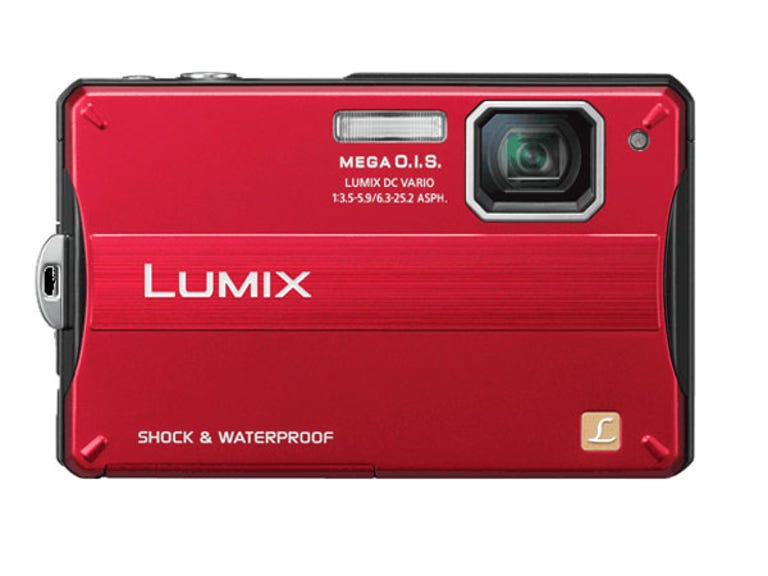 Why You Can Trust CNET
Why You Can Trust CNET Panasonic Lumix DMC-FT10 review: Panasonic Lumix DMC-FT10
If you want a basic tough camera and can live with its quirks, the FT10 is a decent enough choice.
As the baby sibling to the other tough cameras in Panasonic's Lumix range, the Lumix FT1 and FT2, the FT10 seems a little more demure. It's like an FT series-lite, if you will, sharing some rugged features and eschewing others.
The Good
The Bad
The Bottom Line
Design and features
On the outside, this camera could easily be mistaken for any number of other Panasonic Lumix mid-range cameras, with its box-style exterior and flat panels. But you certainly couldn't throw any of those cameras down the stairs or submerge them into water and expect them to survive the test.
The FT10 is shockproof from drops up to 1.5 metres, waterproof up to 3 metres and freeze proof to -10 degrees Celcius which sounds kind of like the specifications found on the average Olympus tough camera (the 6010). Around the camera body, at the base and the side, are two lockable flaps that house the battery and memory card, plus an AV out and power input. While useful to have these lockable flaps, they can be awkward to get open. While we're on the topic of awkward, like all other tough Lumix cameras, the front lens element isn't protected by a flap; it's left exposed to the elements.
Further around the back is a 2.7-inch LCD screen, with 230,000 dots, paling in comparison to lots of other Lumix cameras from the 2010 range, but on par with many other tough cameras. Buttons around the back and the top of the camera are coated in silver and are utilitarian in appearance. There's an intelligent auto button just next to the shutter button, but there's no one-touch record movie button. Other features include Panasonic's Mega OIS (optical image stabilisation) and HD video recording at 720p in motion JPEG. A 4x optical zoom completes the specifications.
In the box, the FT10 comes with a rubberised protective case, as well as an instruction manual and AV cables. Like any other waterproof camera, there are stringent measures that need to be taken to preserve this feature, all of which are documented on the box itself, and via on-screen prompts.
Compared to

| Panasonic Lumix FT10 | Olympus Tough 6010 | Olympus Tough 8010 |
|---|---|---|
| 14 megapixels | 12 megapixels | 14 megapixels |
| 2.7-inch, 230,000-dot LCD | 2.7-inch, 230,000-dot LCD | 2.7-inch, 230,000-dot LCD |
| Waterproof to 3m, drop proof to 1.5m, freeze proof to -10 degrees Celcius | Waterproof to 3m, drop proof to 1.5m, freeze proof to -10 degrees Celcius | Waterproof to 10m, crushproof to 100kg, drop proof from 2m, freeze proof to -10 degrees Celsius |
| HD video (720p, motion JPEG) | Video (VGA resolution, motion JPEG) | HD video (720p, MPEG-4) |
| AU$399 | AU$399 | AU$499 |
Performance
Image quality
As with most other tough cameras on the market, at least in this price bracket, you need to keep your photo quality expectations in check considering this camera's rugged focus and price point. The first issue that the FT10 has is its tendency to underexpose images in daylight and overcast situations. Colours are accurate, except for at high ISO levels (see below).
An example of the FT10's underexposure. (Credit: CBSi)
Then, at low ISO levels there's a fair amount of digital artefacts across the image. At higher ISO levels, like 800 and 1600, the over-processing starts to cause some colour-shifts. This is as much to do with the megapixel count as the image processor; we only wish Panasonic left the megapixel count the same as the FT1 (12.1-megapixels).
The same image taken with the FT10 (top) and Olympus 8010 (bottom) with 100 per cent crops inset. (Credit: CBSi)
Video quality doesn't fare all that much better, with discernible flares and purple fringing appearing on the image, while the microphone has trouble picking up clear sound when the camera is submerged. Still, it does the job if all you need to do is capture some underwater footage.
Image samples
Click each image below for JPEGs straight from the FT10. No post-processing has been done to alter these photos.
Exposure: 1/200, f/5.8, ISO 200 | Exposure: 1/400, f/7.1, ISO 100 |
Exposure: 1/25, f/4, ISO 1600 | Exposure: 1/400, f/5.6, ISO 80 |
Conclusion
For close to AU$400, the FT10 doesn't seem like it's worth the money given the image quality we've come to expect from other Lumix cameras. Better still, the older original tough model (Lumix FT1) pairs better image and video quality in a package that's just as rugged.
The FT10 is decent enough; just keep your photo and video quality expectations in check given its position in the Lumix tough range.


